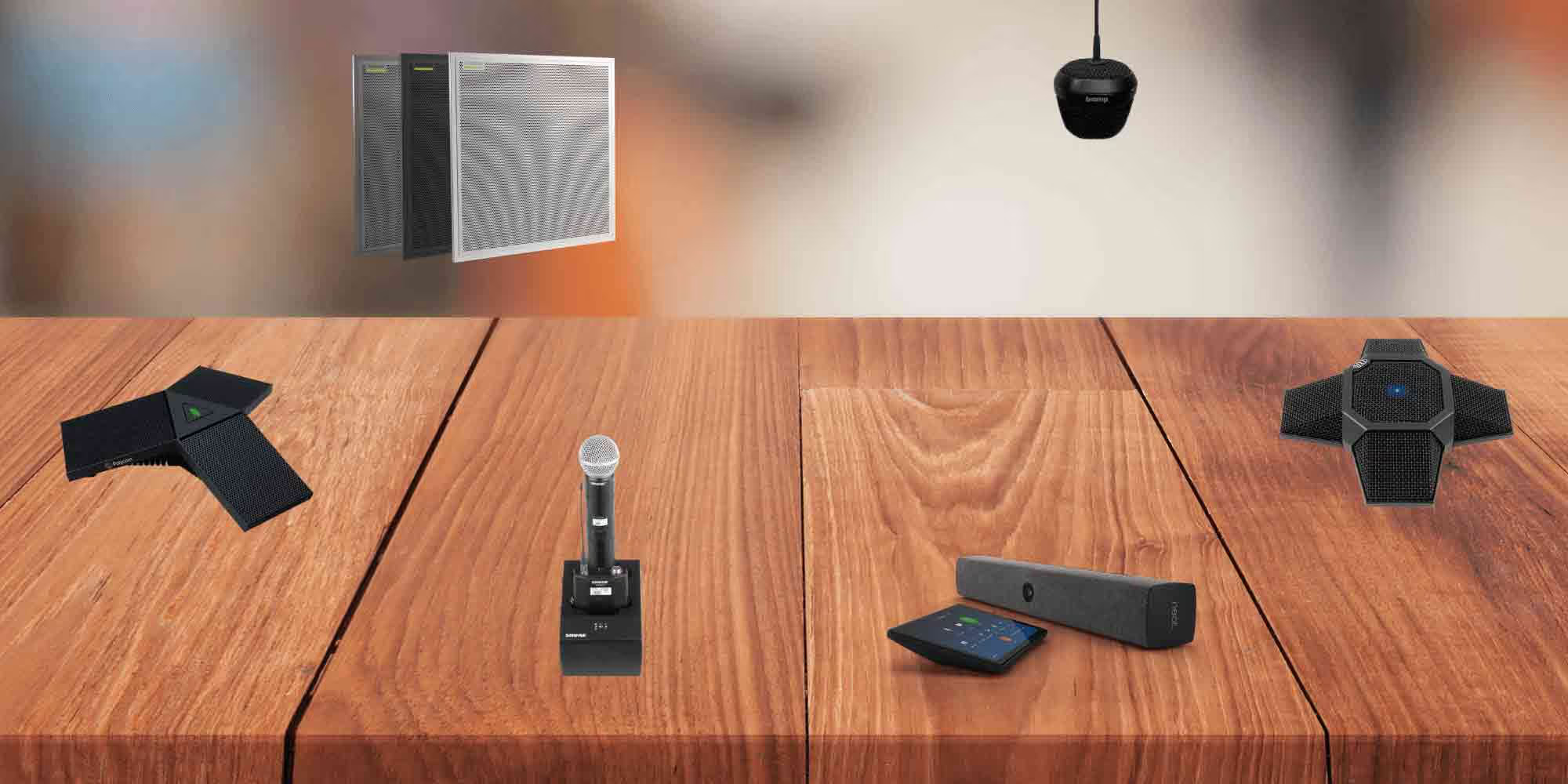Have you invested a significant amount of money in microphone technology? Was the result not as good you expected?
You might be using a great microphone, but in the wrong room.
The performance of any microphone will depend on the environment in which it is being used. Therefore, it is important to select the most appropriate microphone for each unique environment. We talk more about environmental factors in our blog here.
There are a range of high quality professional microphones which can be fully integrated into a range of video conference room types and layouts.
When reviewing your options, some things you should consider include:
- Room size and configuration
- Use cases
- Microphone type
Room Size and Configuration
The number and type of microphones required will largely depend on the size of the room and the way it is configured. In flexible spaces, the configuration may change which adds to the complexity of selecting the right microphone technology.
As an example, in fixed configuration rooms, it is possible to hardwire microphones that are permanently fixed into position on tables. In a flexible room, this would not be possible, therefore ceiling microphones or wireless microphones would be more appropriate.

Use Cases
All of your rooms may serve the same purpose, but it is most likely the requirements will vary.
In order to achieve a high quality outcome, microphone selection needs to align with the specific use cases that apply to each room.
For example, in a presentation space where an individual will be presenting to an audience (both in-room and remote), the presenter will likely move around the stage or room. For them to be heard clearly and consistently, a wireless handheld or lapel microphone would be required, along with the ability to mute or disable any microphones that might be among or above the audience. These audience microphones may still be required to cater for audience interaction e.g. Q&A. It is also important to consider the most appropriate type of microphone for this use, taking into account how it integrates with the overall experience.
In contrast, in a small huddle space, a simple all-in-one collaboration device with a built-in microphone may be sufficient. Participants typically remain in the same spot and speak in the same direction for the duration of the meeting, therefore, multiple microphones in multiple locations are not required.
Microphone Type
All microphones are not equal. They differ in appearance, price, but ultimately performance. In the conference room environment, you will come across a plethora of options, many claiming to work in virtually any space. But this almost certainly is not the case in reality.
A general rule of thumb is the closer the microphone is to the person speaking, the better the result. Having said that, far-field microphones have advanced to a point that they can be installed in the ceiling or at the front of a room, and sound as though they are placed right in front of the talker. These types of microphones make sense for many reasons, but are heavily reliant on acoustics which you can read more about here.
To be more specific, here are some of the different types of microphones worth considering, and why they may or may not be suitable.

Gooseneck microphones are popular for panels, lecture podiums and boardrooms. They provide optimal audio as the speaker is always positioned close to the microphone. These are usually fixed, so the speaker is unable to move around the room when using this type of microphone.
.gif)
Handheld microphones are ideal for multiple speaker(s) in a presentation format. They are usually used in concerts and lectures where presenters can move around the room and easily hand the microphone onto other presenters or audience members.
.gif)
Wearable microphones provide a handsfree experience. A connected headset in the speaker(s) ear may also be used to communicate with offsite participants. These are particularly important for remote education setups.
.gif)
Fixed tabletop microphones provide consistency and control in a static room where the configuration doesn’t change. Some tabletop microphones are often referred to as boundary microphones (the tabletop acts as the boundary). Tabletop microphones usually require talkers to be in a fairly close proximity to achieve a good result.
.gif)
Ceiling microphones remove clutter from tables and typically provide better coverage than tabletop alternatives. However, given their proximity to the talker, they are more easily affected by poor room acoustics. They make sense in flexible meeting rooms as changes to the room configuration do not require any changes to the microphone configuration, unless the specific microphone requires it, e.g. Shure MXA920 which has programmable steerable coverage, meaning you can essentially tell it where in the room to listen and where to ignore.
.gif)
Beamtracking microphones are probably the most advanced conference microphones available. In simple terms, a beamtracking microphone locks onto a source (the person talking), and will focus on that source and follow it as it moves. With the right digital signal processing (DSP) setup multiple beamtracking channels can be mixed together to produce a natural sounding conversation to the far end.
The easiest way to categorise the different types is either directional or omnidirectional.
Every microphone is designed to capture sound in a particular way. A directional microphone will pick up audio from a particular direction whereas an omnidirectional picks audio up from all directions.

The most common type of directional microphone is referred to as a cardioid microphone. These microphones work particularly well when up to two people are sitting within arm’s length. However, these microphones will struggle to capture audio for multiple speakers in a large meeting room.
In general, it is best to have at least one cardioid microphone for every two to three speakers.
Omnidirectional microphones on the other hand work well for multiple people sitting around the microphone. In larger meeting rooms, it is best to have multiple omnidirectional microphones to capture the voice of the speaker(s), wherever they choose to sit. Unfortunately, these microphones tend to pick up more background noise, so it is essential to minimise any potential heating, ventilation, air conditioning noise (HVAC) and other distracting sounds.
When professionally designed and installed, the right microphone technology will seamlessly connect to your video conferencing platform of choice allowing for a high quality audio visual experience.
Are you dealing with bad audio in your conference rooms? Reach out to us here for a chat, we would love to hear from you!



